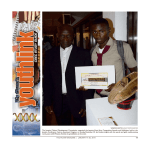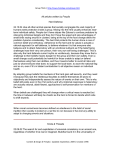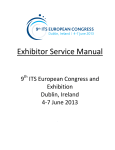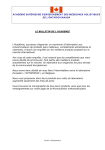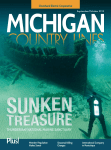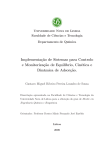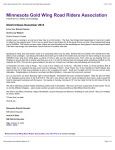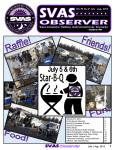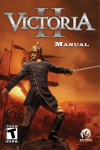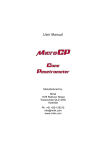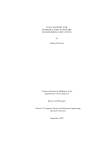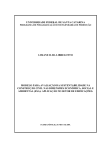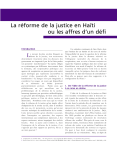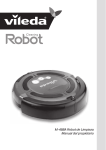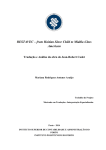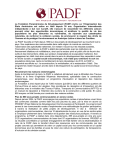Download May your holiday season be blessed with peace,love
Transcript
May your holiday season be blessed with peace,love and joy. Heartfelt wishes with a joy that never ends. YOUTHLINK MAGAZINE | DECEMBER 21-27, 2010 11 yl:mathematics CLEMENT RADCLIFFE Contributor HIS WEEK, we will continue the review of algebra with the solution to last week’s homework. T Simultaneous equations Since 3x2 - 2x + 1 may be expressed in the form y = 3 (x - 1/3)2 + 2/3 Then the equation of the axis of symmetry is x - 1/3 = 0; x = 1/3 The minimum value of y = 2/3 Since y = 3( x - 1/3)2 + 2/3 POINTS TO NOTE The following methods are used to solve quadratic equations: m Factorisation m Formula method N.B. When x = 1/3, then 3 (x - 1/3)2 = 0 therefore y = 2/3 It should be noted that the formula method is used when the quadratic expression cannot be factorised. Let us now review the homework. For all other values of x, 3 (x - 1/3)2 is a positive number therefore y is greater than 2/3 therefore is the minimum value Let us continue by returning to the solution of simultaneous equations. This week I will deal specifically with those cases in which one equation is linear and one is quadratic. Simultaneous equations - one linear and one quadratic. The substitution method is used. Continuing with algebra, we will now review the application of completion of squares. These are: 1. Equation of the axis of symmetry. 2. Maximum or minimum value of the expression. EXAMPLE: Given the expression (a) 2x2 + 4x - 7 (b) 3x2 - 2x + 1 find the following a) The equation of the axis of symmetry b) The minimum value of the expression Since 2x2 + 4x - 7 may be expressed in the form y = 2(x + 1)2 - 9, then the equation of the axis of symmetry is given as x + 1 = 0, therefore x = - 1 The minimum value of y = -9 Do you know why? 12 YOUTHLINK MAGAZINE | DECEMBER 21-27, 2010 yl:principles of accounts ROXANNE WRIGHT Contributor QUESTION: Partnership account On April 1, 2009, Johnny, a trader, agreed to admit Marcus as a partner. $44 000 Cr. However, a revaluation of the business assets showed an increase of $10 000 on their value and the accounts were amended accordingly. [> 1] C. On admission of a new partner, the person has to pay for goodwill as the old partner of the existing business had already created the reputation of the business through his own efforts and skills. Since the new partner is going to benefit from it, he has to pay for it. Marcus was to bring $20 000 cash and a motor vehicle valued at $12 000 into the business immediately. WORKINGS: After recording the above transactions, it was agreed that the capitals were to remain fixed. [>2] It was further agreed that: i. Marcus should receive a salary of $20 000 per annum by credit to his current account at the end of each financial year. ii. Interest on capital should be allowed at the rate of 10% per annum. iii. Marcus should receive a bonus of 10% of trading profit after deduction of interest on capitals. iv. The residue to profit/losses should be divided between Johnny & Marcus in the ratio 3:2. At the end of the first 12 months’ trading, the net trading profit was $88 600 before interest on capital. During the year, drawings were: Johnny $38 000; Marcus $42 000 YOU ARE REQUIRED TO: a. Prepare the Profit and Loss Appropriation Account for the year ended March 31, 2010. b. Prepare the Current Account of Johnny and Marcus for the year to March 31, 2010, duly balanced off, as they would appear in the ledger. c. A person often has to pay for goodwill when admitted as a partner or when taking over a business. Explain briefly why payment for goodwill takes place. SOLUTION: See you next week. Roxanne Wright teaches at Immaculate Academy. Send questions and comments to [email protected] YOUTHLINK MAGAZINE | DECEMBER 21-27, 2010 13 yl:biology Studying the environment (part 2) MONACIA WILLIAMS Contributor OW ARE you this week? Did you get a chance to review the information you received last week? I certainly hope so. Remember that this is information that can be used to answer section A of Paper 02, so you should not take it lightly. Last week, we looked at some of the equipment we can use to study the physical environment such as the quadrat and the line transect. H There is another type of transect that was not mentioned.This is the belt transect. For the belt transect, two parallel lines with a predetermined distance between them are set up. Sampling now takes place between the lines. Belt transects provide more information than line transects because they cover a wider area. Their use can be time-consuming, however. This week, our focus will be more on the animals than on the plants. COLLECTING ANIMALS Animals are everywhere. They include the more obvious vertebrates and the not-so-obvious invertebrates. Some invertebrates are showy and are seen quite frequently, for example the butterflies. There are some that are also seen frequently, but which we wish we didn’t have to see at all, like flies and worms. Others are seen infrequently since they prefer to live their lives hidden from the rest of the world, such as the wood louse, the millipede and the centipede. Wherever these animals are, we would like to know more about them, and in order to do so we will need to get close to them so that we can catch them! How can we do this? Most of these organisms are quite elusive. We can catch them if we use the proper pieces of equipment. These pieces of equipment can be homemade and, hence, quite inexpensive, so there is virtually no excuse for you not to do your own study. Nets are used to catch flying insects or to catch insects that are found in grass or on trees. They are also used to collect aquatic animals. Animals caught in the net are then transferred to jars or pill bottles to secure them. BAGS Something as simple as a plastic bag can be used as a collecting tool. Use your imagination to determine how you can get the animal into the bag! USING JAM JARS A jam jar with a cover can be used to capture a sedentary animal or even one that is creeping or crawling. It can also be converted to a trap to capture crawling animals. RULES FOR COLLECTING BOTH PLANTS AND ANIMALS For the pitfall trap, a hole is dug into the ground and the jar is placed into the hole. The mouth of the jar is covered with a stone in such a way that there are tiny gaps underneath. Animals that walk under the stone will fall into the jar and can then be collected. Depending on how often the bottle is going to be checked, food can be provided for the captured animals. The food can also be used as a lure for the animals. m If the plant is in flower, collect one or two of its flowers as well as a small piece of stem with leaves. m Use a large spoon to collect soil samples. m Scrape off mosses and snails with a knife. m Look under fresh and rotting leaves for animals. m Look under large stones and rotting wood for animals. Remember to replace these. m Put food inside the jars to attract the animals. m Keep animals with a piece of the plant on which they were found. This will provide them with food. m Keep aquatic animals in a sample of the water in which they were found. m Label your containers to indicate where the organisms were found. m Handle all animals with care, returning them to their habitat as soon as you have finished studying them. m Try to make your study non-destructive. NETS See you next week; have fun until then! There are two main types of nets. These are the sweep net and the butterfly net. You can easily construct your own net, using a coat hanger and an old stocking or a piece of mosquito netting. 14 Monacia Williams teaches at Glenmuir High School. Send questions and comments to [email protected] YOUTHLINK MAGAZINE | DECEMBER 21-27, 2010 yl:geography Looking at paper 1 MARJORIE HENRY Contributor N THE last lesson, I started to discuss the map reading skills tested in question 01 of the May 2010 examination paper. The skills identified in that question are grid reference, compass direction, bearing, measuring distance, gradient and description. I dealt with grid reference in that lesson. One of the things I mentioned was that grid reference can be four-or-six figure. I indicated where each is used. I (part 5) Whenever you are given a question on grid reference, take time to read the question carefully to see what is required and answer accordingly. In the question under discussion, for example, you are specifically asked to: ‘State the six-figure grid reference of the police station in the village of Soufriere.’ Do not state four-figure grid reference since that would be an incorrect response. I trust that since the last lesson you have spent some time practising stating grid references by following the guidelines given. Sections (b) and (c) of the question test the skill of stating direction. The direction of one point from another may be expressed by reference compass points or in terms of angular bearings. Section (b) tests direction in terms of compass points and section (c) in terms of bearings. The compass point is always shown on the map. Identify the compass point on any map extract you have. The map often shows the magnetic north, grid north and the true north. Your concern is for the true north. There are other points between these points. These are indicated in the diagram below. The true north is shown on the map by an arrow which is parallel or nearly parallel to the edge of the map. North is one of the four cardinal points. The others are south, east and west. I am certain that you all are familiar with these. However, students are often uncertain of the position on the compass. The diagram below shows their positions. Sixteen points are shown. Observe closely their positions and memorise them. Complete the following exercise to assist you further in becoming familiar with all 16 points. Do them without looking at the diagram. CARDINAL POINTS Here is a little reminder about the position of the points. Whenever you show the positions of west (W) and east (E) on a diagram of the compass, you must spell the word WE. There are several other points in addition to the cardinal points. Look at the diagram and identify them. YOU SHOULD BE ABLE TO IDENTIFY THAT: m NE is halfway between north and east and is opposite SW m NW is halfway between north and west and opposite SE m NNE is halfway between north and north-east and is opposite SWW m ENE is halfway between east and north-east and is opposite WSW 1. SE is halfway between _______ and _____ and opposite _____ 2. SW is halfway between ______ and ______ and opposite _____ 3. NNW is halfway between _____ and _____ and opposite ______ 4. SSW is halfway between ______ and ______ and opposite ______ 5. SSE is halfway between ______ and ______ and opposite ______ 6. WNW is halfway between ______ and ______ and opposite ______ 7. WSW is halfway between ______ and ______ and opposite ______ (Source for diagrams: Skills in Geography in Secondary School by V.A. Rahil) Marjorie Henry is independent contributor. Send questions and comments to [email protected] YOUTHLINK MAGAZINE | DECEMBER 21-27, 2010 15 yl:information technology System and application software NATALEE A. JOHNSON Contributor E WILL continue to look at the choice of O/S which is dependent on the processing environment required by the user. The first environment we looked at last week was batch processing. Let us look at the others: W TIME-SHARING MULTIPROCESSING The processor’s time is divided into small units called time slices and shared, in turn, between users to provide multi-access. These systems allow the CPU to switch between different programs rapidly, so that users are unaware that they were time-sharing the CPU with others. Several persons can connect to the main computer via dumb terminals and access different application programs. SINGLE-USER PROCESSING SYSTEM These systems came on the scene with the advent of personal computers. The majority of small microcomputer-based systems have operating systems which allow a user to operate the machine in an interactive conversational mode (response to the user’s message is immediate), but normally only one user program can be in main storage and processed at a time; there is no multiprogramming of user programs. Multiprogramming occurs when more than one program in main storage is being processed apparently at the same time. This is accomplished by the programs taking turns at short burst of processing time. SINGLE-USER MULTITASKING This system only allows one person to use the computer at a time to do multiple tasks. REAL-TIME PROCESSING This is a system that is able to process data so quickly that the results are available to influence activity currently taking place. There is often a need for multi-processing. Multi-processing is the name for the situation that occurs if two or more processors are present in a computer system and are sharing some or all of the same memory. In such cases, two programs may be processed at the same instance. These systems are used mainly in critical systems. Critical systems are systems where delay in the processing of data after its input can lead to the destruction of life and property. Examples of critical systems are systems that monitor critically ill patients, nuclear plants, the engine of an aeroplane, etc. UTILITY SOFTWARE (We made reference to this in our previous lesson). Utility programs perform tasks related to the maintenance of your computer’s health, hardware or data. Some are included with the operating system, others can be bought as a separate package. Utility programs perform tasks such as: m File management m Disk management m Backup m Data recovery m Data compression m Antivirus programs USER INTERFACES The interaction between end-users and the computer is said to take place at the human-computer interface (HCI). The term humancomputer interface is meant to cover all aspects of this interaction, not 16 (part 3) just the hardware. One of the most important features normally required in an HCI is that it be user-friendly. As the name suggests, a user-friendly interface is one that the end-user finds helpful, easy to learn about and easy to use. It is easy to recognise unfriendly interfaces but not so easy to design one that is certain to be userfriendly. TYPES OF INTERFACES There are many different types of user interfaces available. They may be broadly classified as follows: m Command-driven interfaces m Menu-driven interfaces m Direct manipulation interfaces m User interface management system (UIMS) m Special purpose interfaces m Graphical user interfaces many different alternative forms of menu. The simplest menus provide the user with a number of options and a simple means of selecting between them. The user is presented with a choice and, therefore, does not have to remember any commands. The interface is, suitable for beginners and infrequent users. All the user has to do is to make a choice. A special type of menu called a pop-up menu; an additional sub-menu pops up as a selection is made. You can click anywhere on a given document using the right-click mouse button to allow a popup menu to appear. Pull-down menus are a special type of menu used in windowing and were briefly introduced. It is a menu displayed as a vertical list which hangs from a horizontal bar on the screen in order to elicit a choice from the user. Note: In some situations, two different types of interfaces may be combined, for example, a menu interface with command options. ADVANTAGES OF MENU-DRIVEN INTERFACES COMMAND-DRIVEN INTERFACES One of the long-established methods by which a user can interact with the computer is by the use of commands. Commands enable the user to quickly and simply instruct the computer on what to do. However, they require the user to already have knowledge of what commands are available, what they do and the rules governing how they should be typed, so they are more suited to experienced users than the end-user. A technical person such as a computer operator or programmer would be familiar with the commands, or where the enduser continually works with the same program and, therefore, can gain mastery of the commands. m The user is presented with a list of options to choose from; they do not need to remember the commands m Free from typing errors because the user does not have to type the commands m A wide variety of input devices can be used to interface with a menu DISADVANTAGES OF MENU-DRIVEN INTERFACES m Several steps are required to issue a command m Once the user has learnt the menu system, it is bothersome to have to wait on the package to present the questions before the commands can be entered ADVANTAGES OF COMMAND-DRIVEN INTERFACES m Faster to use once you have learnt the commands m For a computer programmer, command-driven interfaces are cheaper to implement DISADVANTAGES OF COMMAND-DRIVEN INTERFACES m It is sometimes difficult to remember all the commands, therefore, users have to constantly refer to the software user manual m The user is restricted to using only the keyboard as the interfacing device, while, with other interfaces, a wide variety of input devices can be used m Commands must be entered at a special location on the screen and in a set format We have come to the end of this week’s lesson. See you next week when we’ll finish looking at user interfaces and conclude the topic a system and application software. Remember, if you fail to prepare, prepare to fail. MENU-DRIVEN INTERFACES Menus provide another popular form of user interface. There are YOUTHLINK MAGAZINE | DECEMBER 21-27, 2010 Natalee A. Johnson teaches at Ardenne High School. Send questions and comments to [email protected] yl:chemistry Carlong Publishers (Caribbean) Limited Partners in the education process Building 3, 17 Ruthven Road, Kgn 10, Ja, W.I. Tel:(876) 960 9364-6 Fax: (876) 968 1353 www.carlongpublishers.com FRANCINE TAYLOR-CAMPBELL Contributor YOU SHOULD BE ABLE TO: m Define the Faraday’s constant m Perform calculations involving the mole Faraday and electrochemical calculations Carlong Publishers (Caribbean) Limited Partners in the education process Building 3, 17 Ruthven Road, Kgn 10, Ja, W.I. Tel:(876) 960 9364-6 Fax: (876) 968 1353 www.carlongpublishers.com EXAMPLE What mass of lead would be produced by a current of 5A, passed through molten lead bromide for 1hr? C = A x s C = 5 x 60 x 60 = 18,000C 2+ POINTS TO NOTE m The faraday (F) is the quantity of electricity needed to remove one mole of electrons from the cathode during electrolysis or to deposit one mole of electrons on the anode during electrolysis. m The Faraday’s Constant is the amount of electric charge carried by one mole of electrons, that is 96,500C. During electrolysis, electrons are taken from the cathode by positive ions called cations. EXAMPLE + 2H (aq)+ 2e = H2(g) The ions are said to be discharged. 2+ Cu (aq) + 2e = Cu(s) Electrons are deposited on the anode (+ve) by negative ions called anions. One faraday = 96,500 coulombs, ie, 1F = 96,500 C The coulomb is the unit of electrical charge and is 1 ampere flowing for 1 second(s). ie coulombs = amps x sec, quantity of electricity = current x time (Q = I x t) Now Pb (l) + 2e = Pb(l) 2F 207g 193,000C = 207g Pb Thus, 18,000C = (207/ 193,000) x 18,000 = 19.2g Pb EXAMPLE EXAMPLE When 2 amps flow for 1 minute, the quantity of electricity flowing (Q) Q = 2*60 = 120C NOTE What volumes of (a) H2 (b) O2 would be liberated at R.T.P when 0.1F is passed through dilute sulphuric acid? + 4H + 4e- = 2H2 4OH = 2H2O + O2 + 4e+ The faraday may also be regarded as the charge on 1 mole of electrons. Thus: F = Le L = Avogadro’s number E = the charge on one electron Calculate the volume of H2, for example, 2H + 2e = H2 2F 1mole = 24 dm3 at R.T.P Thus 0.1F = (24/2) x 0.1 dm3 = 1.2 dm3 H2 at R.T.P And volume of O2 = 0.6dm3 at R.T.P ( from above equations) EXAMPLE - 2Cl (aq)= Cl2(g) + 2e - 4OH = 2H20 + 02 + 4e Electrons may also leave from the anode if the anode dissolves. EXAMPLE 2+ Cu = Cu + 2e - yl:office adminiatration FURTHER EXAMPLES What mass of copper would be deposited during electrolysis by 0.5F? 2+ Cu + 2e = Cu 2F 64g Thus 0.5F = 16g Cu HYACINTH TUGMAN Contributor Test yourself Based on the units we have covered so far, I am giving you a quiz to test your readiness for your upcoming examination. GOOD LUCK! 1. Which of the following organisations/businesses will at some time be involved in office activities? I. Schools II. Recreational centres III. Hairdressing salons IV. Departmental stores (a) I only (b) I and IV only (c) I, III and IV only (d) I, II, III and IV 2. You are a clerk in a small organisation. Your supervisor is the secretary and the head of the organisation is the general manager. You feel that some improvements can be made in the filling system. What should you do? (a) Discuss your ideas with the secretary (b) Make the changes you feel are necessary (c) Continue with the old system until you are asked for an opinion (d) Discuss your ideas with the general manager You will be given more questions in next week’s lesson to enable you to master this topic. Francine Taylor-Campbell teaches at Jamaica College. Send questions and comments to [email protected] 3. Which of the following items of information could be obtained from an airline schedule? I. The cost of fares for the airline II. The flight number of the airline for a particular route at a specified time III. The identification of the aircraft used by an airline IV. The times at which the airline flies to and from different airports (a) I, II and III only (b) I, II and IV only (c) I, III and IV only (d) II, III, and IV only 4. An officer left last night for a three-day business conference in another Caribbean territory. You have just seen on your desk a copy of a very short letter which you had prepared for his folder. Which of the following is the most appropriate action to take? (a) Send the details of the letter by electronic mail (b) Send a copy of the letter by special delivery (c) Tell him the details of the letter by telephone (d) Assume that he no longer requires the letter and file it 5. For what purpose should a memorandum be used? (a) Communication with external business associates (b) For messages received from external callers YOUTHLINK MAGAZINE | DECEMBER 21-27, 2010 (c) Informal confirmation of business (d) Communication within an organisation 6. A quorum is constituted of the (a) Minimum number of members to be present for a meeting to be called to order (b) Specific executive members who must be present for a meeting to be conducted (c) Executive members of the committee present at the meeting (d) Number of members present at a meeting 7. The correct procedure for a receptionist to use when introducing a visitor to a staff member is to announce the (a) Visitor’s name (b) Visitor’s name and company (c) Visitor’s name, title and company (d) Visitor’s name, company and title 8. Microfilming is used primarily to (a) Start a new filing system (b) Economise in the use of storage space for files (c) Sort files for numerical filing (d) Destroy old records PLEASE SEE TEST, PAGE 18 17 petty cash vouchers? (a) Circular rotary file (b) Concertina file (c) Visible index file (d) Card wheel index file Test CONTINUED FORM PAGE 17 9. A clerk was asked to file some invoices in chronological order. These documents should be arranged by (a) Date (b) Reference number (c) Order number (d) Quantity delivered 10. Which of the following items would be most suitable for filing 11. A busy receptionist remembers having taken a call for a company executive from a regular client, but cannot find a record of the message. What does she do? (a) Decide not to mention the call (b) Apologise and explain that she was busy (c) Call the client to get the information (d) Hope for the client to call again 12. If all members at a meeting voted in favour of a motion, the motion is said to have (a) Been carried unanimously (b) The majority vote (c) Been voted for en bloc (d) Been carried nem con Have a wonderful Christmas and remember not to forget the real meaning of Christmas. See you next week with the answers. Hyacinth Tugman teaches at Glenmuir High School. Send questions and comments to [email protected] yl:social studies MAUREEN CAMPBELL Contributor Elections m An election is a formal process by which voters make their political choices on public issues or candidates for public office. This is done by choosing a candidate for office by the vote of those enfranchised to cast a ballot. m The voting or electoral system is a method by which voters make a choice between options, often in an election or on a policy referendum. m A voting system contains rules for valid voting and how votes are counted to yield a final result. Common voting systems are majority rule and proportional representation voting with a number of variations and methods such as first-past-the-post or preferential voting. m If every election had only two choices, the winner would be determined using majority rule alone. However, when there are three or more options, there may not be a single option that is preferred by a majority. Different voting systems may give very different results, particularly in cases where there is no clear majority preference. m A voting system specifies the form of the ballot, the set of allowable votes, and the tallying method and an algorithm for determining the outcome. This outcome may be a single winner or may involve multiple winners such as in the election of a legislative body. The voting system may also specify how voting power is distributed among the voters and how voters are divided into subgroups (constituencies) whose votes are counted independently. m Government is a system of social control under which the right to make laws and enforce them is vested in a 18 particular group in society. Governments are distinguished by whether power is held by one man, a few or a majority, and the degree of control exercised over the society. m Organisationally, governments may be classified into parliamentary or presidential systems, depending on the relationship between executive and legislature. Government may also be classified according to the distribution of power at different levels. m The basic law determining the form of government is called the constitution, which is the fundamental principles of government in a nation, either implied in its laws, institutions and customs, or embodied in one fundamental document. FUNCTIONS OF GOVERNMENT m Governments perform many functions besides the traditional ones of providing internal and external security, order and justice. Most are involved in providing welfare services, regulating the economy and establishing educational systems. m A political party is a group of persons organised to acquire and exercise political power. All parties develop a political programme that defines their ideology and sets out the agenda they would pursue should they win elected office or gain power. Most countries have single-party, two-party, or multiparty systems. A constituency is the whole body of voters who elect one representative to a legislature or all the residents represented by one elected candidate. It may also be seen as a district that sends one representative to a legislature. A candidate is an individual contending or being considered for a government or public post, such as a parliamentary candidate. The electorate is the body of all qualified voters. The floating voter is a person who does not vote consistently for any single political party. A representative is a member of a governmental body, usually legislative, chosen by popular vote. This person is authorised to act as an official delegate or agent. Franchise is a privilege or right officially granted to a person or a group by a government, in this case it is the constitutional or statutory right to vote. A manifesto is a public declaration of principles, policies or intentions, especially of a political nature. A ballot is a sheet of paper or a card used to cast or register a vote, especially a secret one. Hung parliament, in parliamentary systems, is one in which no one political party has an outright majority but it is equally balanced. In these circumstances one party does not hold enough seats to form a majority. A hung parliament will force a coalition government, a minority government or a dissolution of Parliament. A coalition government is a cabinet of a parliamentary government in which several parties cooperate. The usual reason given for this arrangement is that no party on its own can achieve a majority in the parliament. Suffrage determines who can vote in an election. It answers the question who may vote on a central issue in elections. The electorate does not generally include the entire population. For example, many countries prohibit those judged mentally incompetent from voting, and all jurisdictions require a minimum age for voting. FIRST PAST THE POST The term first past the post (abbreviated FPTP or FPP) was coined as an analogy to horse racing, where the winner of the race is the first to pass a particular point on the track, after which all other runners automatically and completely lose; the payoff is winner takes all’. There is, however, no ‘post’ that the winning candidate must pass in order to win; he/she is only required to receive the largest number of votes in his/her favour. VOTING In an election for a legislative body, each voter in a given geographically defined electoral district votes for one candidate from a list of candidates competing to represent that district. PROPORTIONAL REPRESENTATION (PR) Sometimes referred to as full representation, is a class of voting system aimed at securing a close match between the percentage of votes that groups of candidates obtain in elections YOUTHLINK MAGAZINE | DECEMBER 21-27, 2010 and the percentage of seats they receive, for example, in legislative assemblies. ACTIVITY 1. What is the term used to describe the right of a citizen to vote. 2. What is meant by each of the following terms? m National/general elections m candidate m franchise m constituency m political party m ballot box m polling station 3. Explain why it is in the interest of a citizen to vote. 4. Under this system, the whole country is treated as a single constituency and each political party puts up a list of candidates to fight the elections en bloc. a. Name the type of electoral system referred to in the statement above. b. Name one territory in the Caribbean which uses it. c. Name one other type of electoral system found in the Caribbean. 5. Find out how the method of allocating seats after a general election differs under both systems. 6. As a leader of a political party, outline three important points you should make to your supporters regarding the benefits to be gained by a named type of electoral system. Give reasons why you would choose this system. Maureen Campbell teaches at St Hugh’s High School. Send questions and comments to [email protected] yl:english language Writing the short story: NATASHA THOMAS-FRANCIS Contributor AST WEEK, we began our discussion on story writing. We looked at examples of character and setting descriptions. I hope you reread those descriptions and took note of how the writers brought those descriptions to life. Of course, in a story you cannot merely describe characters and setting without putting them in the context of a plot. So, this week, we shall take a journey into story land by focusing on plot development. L In addition to characterisation and setting, narrative plot is a very important element of story writing. The plot is a series of incidents or the design of a story. A story may be written in chronological order, however, some skilful writers employ the flashback technique (this we will discuss in another lesson). Most plots contain the following key aspects: plot development to his knees on the ground. The screeches of Arabic curses seared his mind; he closed his eyes and wondered, “Is this what going on means?” How ironic it was that the passionate speech, fired with patriotism, had been given what felt like centuries ago, on the soil of a country he doubted his feet would ever kiss again. How ironic that he, a humble field soldier, now gambled with his life and a dubious metallic weapon, on the battlefield of someone else’s was, while the illustrious commander was tucked away safely home, no doubt commenting gravely on the exploits of ‘our boys out there’. if you live up to the challenge, so will you. Do your country proud.” He struggled to rise to his feet at the same time dreading the visual holocaust sure to assail him. The centre of the town’s once-prosperous financial district had been transformed into a base of squalor and destruction, where blood ran in the gutters instead of water ... oh, for a taste, a drop of water, the soldier thought, raising his eyes to the relentlessly blazing Middle-Eastern sun. Mere feet away from him, children garbed in tattered rags kicked at the remains of a decaying mongrel. The stench of putrescence that rose from its desiccated limbs ought to have made them vomit, but they surely had nothing to expel from their bellies save gastric acid. Surely, these people were promised food from my country, he wondered, the benevolent gesture of a superior nation, confident of its victory? No ... then it seems the first casualty of war is truth. Write a story which begins with these words. Can you identify the exposition in this story? “Some people never give up. They keep going on and on and on. People of this calibre have forged themselves a place in history’s archives, boys, and The words of the arrogantly confident field commander whistled through his ears as a landmine exploded behind him. The blast of choking sulphur and ash rocked him, sending him EXPOSITION the beginning or introduction which includes the scene or setting and the introduction of the main character(s). INITIATING EVENT This starts the plot moving; it introduces the conflict. CRISIS This is a moment of difficulty or danger which the main character(s) experience. There may be more than one in a story. However, in a short story, there should not be too many crises. I’m sure you were able to identify the main character and setting in the introduction (exposition) of this story. The main character is a soldier who is obviously unimpressed with his own country’s contribution to a country to which he has been sent. Which phrases indicate the narrator’s cynical tone? CLIMAX The point at which the story reaches its highest interest or the moment of highest tension for the reader. RESOLUTION The setting is a poverty-stricken, almost forsaken, town in a Middle-Eastern country. Phrases such as a base of squalor and destruction, blazing Middle-Eastern sun, desiccated limbs and stench of putrescence paint a picture of oppression and dearth. An apparent war is taking place, depicted by the following phrases: blast of choking sulphur and ash rocked him, visual Holocaust and where blood ran in the gutters instead of water. Are there any other words or phrases which have contributed to a description of the setting? Remember that setting is not just physical space; it is also the atmosphere and mood created. The point at which the event (conflict) is resolved. The outcome might be either happy or disappointing. This is the basic framework/structure of any story. It is important that your story contains all of these elements if you wish to receive a good mark in the examination. One weakness highlighted in the English A CXC examiners’ report is that weak students tend to write a report of events rather than a well-developed plot. Therefore, you must pay keen attention to plot structure when writing your own stories. What do you believe will happen next in the story? In next week’s lesson, I will give you the second part. In part two, you will find the initiating event, the climax as well as the resolution. So, see you then. Have a blessed and productive week! I want you to read part 1 of a short story that was considered the top story by CXC examiners in a previous examination year. I consider it to be a very good example of plot development. The stimulus item for the story was: “Some people never give up. They keep going on and on and on.” Wonder what Keith Hinds and members of the Bridgeport High School choir find so amusing? YOUTHLINK MAGAZINE | DECEMBER 21-27, 2010 Natasha Thomas-Francis teaches at Glenmuir High School. Send questions and comments to [email protected] 19 yl:history DEBBION HYMAN Contributor TOUSSAINT L’OUVERTURE Toussaint was a slave from a plantation in the north. He was the son of a Dahomey man called Pierre Baptiste who had come to St Domingue as a slave. In his early years Pierre had been sold to some Jesuit fathers who taught him the Catholic faith. He had also learnt a good deal about books from them. When the Jesuits left St Domingue he was freed with the other slaves. Toussaint’s father taught him to read and write the French language but he was too poor to buy his son out of slavery. Toussaint apparently read many books during his spare time which were loaned to him by the plantation overseer. He was not a field slave but worked in the stables where he had plenty of time to listen to the conversations of the whites. Toussaint had little or no part in the 1791 rising but in the subsequent confusion he became the leader of one of the many marauding bands which roamed the plain. At first, he offered his services to the Spanish in Santo Domingo as a mercenary but by 1794 he offered his services to the republican army of France, and directed all his energies against the English invaders and their allies, the French planters. He quickly became the dominant figure on the republican side, commanding an army devoted to his person and enjoying the respect, indeed the friendship of powerful people abroad. It was his friendship with John Adams that enabled him to secure from the United States the ships and supplies he needed to fight the English. By 1798 he had so worn down the invaders that the English commanding officer was glad to withdraw his depleted forces. The Haitian Revolution (part 2) general for life; a step which Napoleon himself, the new ruler of France, had not yet ventured to take. There was no room within the French empire for two dictators and Napoleon’s irritation at the prestige and pretensions of ‘gilded Africans’ was partly responsible for Toussaint’s fall. Napoleon had other motives, however, more practical than mere irritation. His political plans called for alliance with Spain but Toussaint, in 1801, in defiance of Napoleon’s orders, had carried out a rapid and successful invasion of Santo Domingo, which had been, in the past, a source of great wealth to France and could be so again. Napoleon also wanted to restore the old system, slavery and all. None of these plans could be executed while Toussaint ruled St Domingue and his removal could be achieved only through a military reconquest of the island. A formidable army of 20,000 troops was sent to St Domingue under General le Clerc, Napoleon’s brother-in-law. This was the largest military expedition ever to sail from Europe for the Western hemisphere. Le Clerc landed at CapFrançais in the north and demanded its surrender. Toussaint’s commander there refused and set fire to it instead. The French, therefore, decided to use force. They were successful, at first, especially with the mulattoes fighting on their side, but Toussaint, Christophe and Dessalines conducted a series of brilliant campaigns which had the French, by April 1802, on the edge of disaster. As well as having to fight Toussaint’s troops and guerrillas, they were beginning to succumb to yellow fever like the British before them. Toussaint, however, did not realise this, so instead of pressing home his advantage, he came to terms with Le Clerc who had insisted that all Napoleon wanted was their oath of allegiance and the surrendering of their guns. Dessalines and Christophe were to accept commands under the French and he would retire to his country estate. However, Toussaint was tricked and he and his family were arrested and sent to France where he died in prison. The betrayal of Toussaint had confirmed the suspicions and worst fears of the blacks in St Domingue. It was impossible for them to any longer accept the word of the French, and armed bands of freedom fighters began to form in the mountains. Their numbers multiplied as news arrived that slavery had been restored in the other French West Indian colonies. Christophe, Dessalines and others broke with the French and took up their position again at the head of their own forces. A period of intensely savage fighting followed. The French eventually gave grounds as they were decimated by the ex-slaves and by yellow fever. Reinforcements were sent out from France, but in 1803 war broke out between France and Britain and St Domingue was soon blockaded by British ships which effectively cut off men and supplies from the French forces in the island. The French leader was, therefore, forced by circumstances to evacuate his troops. He preferred to surrender to the blockading British than to the black rebels. Dessalines thereafter took control of events in St Domingue. He embarked on a campaign of literal extermination of the surviving whites. He had been the most able and ruthless of Toussaint’s generals. Unlike Toussaint, he was Africa-born. At the outbreak of the revolt, he was a slave on the plantation of a free black, whose With the English expelled, Toussaint turned upon the mulatto faction of the west and south, defeated its leader Riguad, himself a soldier of considerable ability, and sacked the town of Les Cayes which had been its headquarters. There followed a systematic round-up mutilation and murder of some 10,000 mulattoes, men, women and children. Politically, by 1800 Toussaint was supreme within the colony. He was able to secure either the compliance or the removal of all officials sent out to the colony from France. He had already, in 1799, been formally appointed governor general by the government in France. After 1800, Toussaint put a stop to indiscriminate massacres and ordered the now ex-slaves back to work. He even induced some of the white immigrants to return to their estates and revived them. Toussaint later drew up a constitution in which he proclaimed himself governor 20 name he assumed and whose property he seized as soon as the insurrection gave him the opportunity of murdering his master. He quickly rose to power in the entourage of Toussaint, and was Toussaint’s enthusiastic agent in the massacre of mulattoes in the south in 1800. He was the obvious successor to Toussaint and in 1804 proclaimed himself emperor of independent Haiti (the original Taino name). He ruled until 1806. His policies, however, spurred the mulattoes to rebel against him. In fact, he was killed by a 14-year-old mulatto assassin. After his death, Haiti was divided between rival successors, the black Christophe in the north and the mulatto Petion in the south. This continued until Christophe’s death in 1820, when Jean Pierre Boyer, a mulatto leader educated in France, succeeded in uniting blacks and mulattoes and became president in 1820. EFFECTS OF THE HAITIAN REVOLUTION HAITI m Emancipation for the enslaved Haiti became the first black state in the Caribbean and, in fact, the Americas. m It created political instability, especially after 1818, when dictatorship marked the nation’s history. m The economy was destroyed as farming declined considerably. Sugar production fell from 163,000,000 lb in 1791 to 1,800,000 lb in 1818. CARIBBEAN m There were a series of sympathetic revolts, for example in Jamaica (Maroons), St Vincent (Black Caribs) and Grenada (Fédon) in 1795. m There was an increase in sugar prices with the decrease production from St Domingue. The British West Indies prospered during this period. m Islands such as Jamaica, Cuba and Puerto Rico profited immensely from planters fleeing St Domingue, who introduced and developed agricultural crops in these areas. For example, these immigrants created coffee estates in Jamaica. SUGGESTED READINGS / WINSTON SILL FREELANCE PHOTOGRAPHER The Jamaica Cultural Development Commission’s (JCDC) 2010 Excellence Awards for the Performing Arts ceremony was held at the Knutsford Court Hotel, Ruthven Road. Here, the Marcus Garvey Award is presented to Ardenne High School. From left are Johnnel Smith, Miss Jamaica Festival Queen 2010; Jomo Dixon; Shanique Brown; Kevoy Burton; Suzanne Beadle, head of speech and drama; Jason Lovelace, teacher; Renae Williams; and Grace Silvera, executive director, JCDC. YOUTHLINK MAGAZINE | DECEMBER 21-27, 2010 1. History of the West Indian Peoples, Bk. 4 - Carter, Digby & Murray 2. A Short History of the West Indies - Parry & Sherlock 3. History of the West Indies - A. Garcia 4. Caribbean Revision History for CXC - Ashdown & Humphreys Debbion Hyman teaches at St Hugh’s High School. Send questions and comments to [email protected] yl:english literature ‘The Merchant of Venice’ BERYL CLARKE Contributor HE THEME appearance versus reality should have occupied your minds in the last week as you spent time contemplating the drama, The Merchant of Venice. I did point out then that one outstanding aspect of this is brought out through the method devised by Portia’s father to ensure that she gets a good husband. T Her father, knew how easily one can be taken in by that which appears to be good, beautiful and appealing to the eye. He also realised that sometimes a goodly outside masks a rotten core. It is for this reason that he puts his daughter’s likeness in the casket of lead, in the hope that a discerning man would not be daunted by outward appearance but would ‘see’ the real worth beneath the unattractive exterior. Another, and equally important, example of this occurs when Portia and Nerissa dress up as a lawyer and his clerk, respectively, and go to court to defend Antonio. The outcome of the case depends on the role they play and particularly on Portia’s ability to argue with confidence and to find that little twist which had been overlooked before but which leads to Shylock becoming the loser. Portia is presented as an exceptionally intelligent human being, sensible and witty before she has to pretend to be a lawyer and, therefore, we are not surprised at her skill. However, had she not appeared to be what she wasn’t, that is a man, she could not have appeared in court. Do you know of any other character who appeared in a guise that was not normal? It was only for a brief time, but it was designed to (part 3) very clear. If she could have told him which casket to choose she would have done so. In fact, she tries to dissuade him from selecting a casket soon after he arrives, for she is afraid of losing his company too soon; in the event that he fails in this venture. make good an escape. I just gave it away; didn’t I, with the use of the word ‘escape’? Yes, it is Jessica. Not only did she want to escape from Venice without attracting undue attention which may have made it easy for her father to find her, but she could not climb down from a window in one of the long, possibly flowing dresses worn by women in those days. If we need more proof of the way she feels, we only have to consider her reaction at his success in winning her. Her joy is obvious! This is also demonstrated in her willingness to assist her husband in his urgent desire to go to Antonio’s rescue after he marries her. She also seems eager to hand over herself and her wealth to him. You, no doubt, have identified love as a theme in this play. There are three marriages in The Merchant of Venice and any discussion on love must include an examination of them. Two of them seem to be based on genuine affection. Let us look at the relationship between Portia and Bassanio. Portia is, indeed, fortunate that the man she loves is the one who wins her by choosing the correct casket. This proves that her father’s arrangement was not as foolish as it may, at first, have appeared. One may be less certain of Bassanio’s feelings, for when he initially shares his intention with Antonio to vie for Portia, he says nothing about loving her. He is going, he says, to repair his economic position so that he can pay off his creditors, including Antonio. Remember, though, that he speaks then about her beauty, strength and wealth, suggesting admiration for her character as well as her possessions. In addition, when he goes to Belmont, his speeches reveal his deep affection for her. On the other hand, Portia makes her love for Bassanio Lorenzo and Jessica also marry, bringing together a Christian and a Jewess. One cannot question their love for each other for they both declare it. Their ability to tease each other and to play with each other shows the strength of their relationship. As for the third couple, Gratiano and Nerissa, there is no evidence to suggest that they fall in love. Their association appears to have been created to form a parallel with that of Bassanio and Portia’s relationship. Please be mindful of the fact that Nerissa only agrees to marry Gratiano if her mistress Portia is going to marry Bassanio. There is one other alliance for us to talk about but that will have to be in our next lesson. Until then, keep your dignity and your hope high and God bless! Beryl Clarke is an independent contributor. Send questions and comments to [email protected] / IAN ALLEN PHOTOGRAPHER Reverend Glen Archer congratulates his pupil Hanif Brown of Ardenne High school after he sucessfully spelt the word Pedilection to win the Spelling Bee championship for St.Andrew. YOUTHLINK MAGAZINE | DECEMBER 21-27, 2010 21











